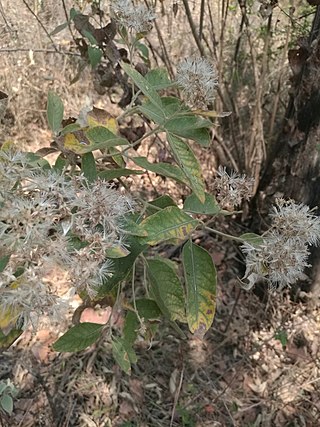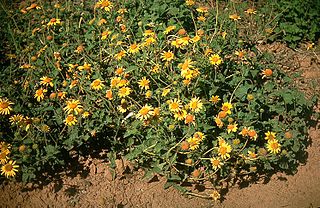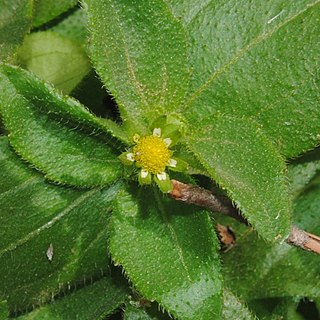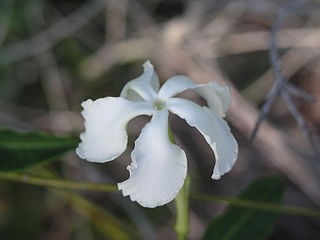
Plumeria, also known as frangipani, is a genus of flowering plants in the subfamily Rauvolfioideae, of the family Apocynaceae. Most species are deciduous shrubs or small trees. The species variously are endemic to the Neotropical realm, but are sometimes grown as cosmopolitan ornamentals in warm regions.

Zamia is a genus of cycad of the family Zamiaceae, native to North America from the United States throughout the West Indies, Central America, and South America as far south as Bolivia. The genus is considered to be the most ecologically and morphologically diverse of the cycads, and is estimated to have originated about 68.3 million years ago.
Spilanthes is a genus of African and South American plants in the tribe Heliantheae within the family Asteraceae.

Clethra is a genus of flowering shrubs or small trees described as a genus by Linnaeus in 1753.

Trixis is a genus of shrubs in the family Asteraceae, native to North and South America including the West Indies.

Sideroxylon is a genus of trees in the family Sapotaceae described as a genus by Linnaeus in 1753. They are collectively known as bully trees. The generic name is derived from the Greek words σιδηρος (sideros), meaning "iron", and ξύλον (xylon), meaning "wood."

Pitcairnia is a genus of plants in the family Bromeliaceae, subfamily Pitcairnioideae. It was named for William Pitcairn, Scottish physician and gardener (1711–1791). The genus Pitcairnia ranks as the second most prolific of the bromeliad family. They are most abundant in Colombia, Peru and Brazil, but can also be found in areas from Cuba and Mexico south to Argentina. One species, Pitcairnia feliciana, is found in tropical West Africa and is the only member of the family Bromeliaceae not native to the Americas.

Jungia is a genus of flowering plants in the family Asteraceae. It is native mostly to South America, with one widespread species extending its range into Central America and southern Mexico.

Casasia is a genus of flowering plants in the family Rubiaceae. These shrubs or small trees occur on the Caribbean islands and in one case in Florida. Some of the ten accepted species were formerly placed elsewhere, e.g. in the related genip-tree genus (Genipa), in Gardenia or in Randia.
Decachaeta is a genus of Mesoamerican flowering plants in the family Asteraceae.

Eremosis is a genus of flowering plants in the family Asteraceae.

Flourensia is a genus of flowering plants in the family Asteraceae. It contains subshrubs and shrubs, which are commonly known as tarworts. They are found in the southwestern United States, Mexico, Central America, and South America. The genus name honours French physiologist Jean Pierre Flourens (1794–1867).

Simsia is a genus of flowering plants in the tribe Heliantheae within the family Asteraceae. It includes annuals, herbaceous perennials, and shrubs. They range from the western United States south through Central and South America to Argentina, with the center of diversity occurring in Mexico. The genus is named for British physician and botanist John Sims (1749–1831). Although some species are relatively rare, others have become common weeds that line the roadsides and fields of Mexico, often forming dense stands mixed with Tithonia and other Asteraceae. Some species are known by the common name bushsunflower.

Jaegeria is a genus of flowering plants in the family Asteraceae found from Mexico to South America. The name commemorates Georg Friedrich von Jaeger.

Perymenium is a genus of South American and Mesoamerican plants in the tribe Heliantheae within the family Asteraceae.
Haplophyton is a genus of plants in the family Apocynaceae, first described in 1844. It is native to the southwestern United States, Mexico, Cuba, and Guatemala. It is a suffrutescent herb with alternative leaves and showy colorful flowers.

Echites is a genus of flowering plants in the family Apocynaceae, first described as a genus in 1756. It is primarily native to Mexico, Central America, the West Indies, and the US State of Florida.

Xiphidium is a genus of herbs in the family Haemodoraceae first described as a genus in 1775. It is native to tropical regions of the Western Hemisphere.
Phania is a genus of plants in the tribe Eupatorieae within the family Asteraceae.















